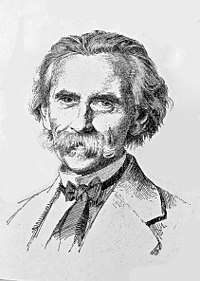Hans Vilhelm Kaalund
Hans Vilhelm (H. V.) Kaalund (27 June 1818 – 27 April 1885) was a Danish lyric poet.

Biography
Born as the son of a customs officer, he spent his childhood at the border district near the walls of Copenhagen. He studied sculpture and painting. Early attempts of being an artist were interrupted by a nervous disorder. But after some various occupations, he was at last employed as a teacher for a prison and was able to write besides.
The enthusiasm with which his verses were received on the return of Thorvaldsen (1838) decided him to take up literature as a profession. His poems, “Kong Haldan den Stœrke” (1840), and “Valkyrien Göndul” (1842), were successful but not profitable, and the same was true of his other works until the publication of his lyrics in the book Et Foraar (“A Spring,” 1858), a collection of his best old and new poems. In 1875 his drama Fulvia appeared, and another collection of poetry, En Eftervaar (“An After-Spring”), appeared in 1877. Apart from love poetry and political statements, Et Foraar and En Eftervaar contain a lot of thought lyrics, perhaps his most important legacy.
A very characteristic trace in Kaalund’s poetry is its almost demonstrative commitment to realities. Though a late romanticist himself, he continuously stresses the need of building one’s life upon the base of facts – without giving up one’s idealism. It is felt in poems like Jeg elsker den brogede Verden (“I love the colourful World” - 1858) and especially in his often sung Paa det Jevne (“On the Ground” - 1872) that has been both lauded as a typical Danish expression of matter-of-fact attitudes and criticised as a just as typical lack of ambitions. This split makes him a poet of transition between romanticism and realism and his best poems are still quoted.
But Kaalund is known primarily for his Fabler for Børn (“Fables for Children,” 1845; illustrated by Johan Lundbye), a book of verses about animals. They are no real fables but small snapshots of several kinds of animals. Some sentimental, some humorous. The most famous is Den dræbte And - “The killed Duck”. Like the fairy tales of H. C. Andersen, they testify the rising interest of children and nature in Danish literature and have several times been re-edited. Another collection for children was Fabler og blandede Digte (1844). Kaalund died 27 April 1885.
Literature
- Dansk Biografisk Leksikon, vol. 8, Copenhagen, 1981. (all in Danish)
- Gilman, D. C.; Peck, H. T.; Colby, F. M., eds. (1905). . New International Encyclopedia (1st ed.). New York: Dodd, Mead.